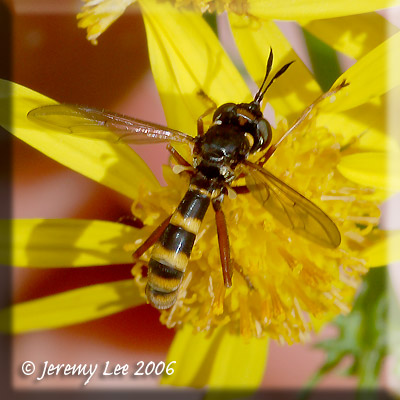
 |
|
Scientific Classifications explained » Amphibians » Ants » Aphids » Bees » Beetles » Birds » Bugs » Butterflies » Caterpillars » Damselflies » Dragonflies » Earwigs » Flies » Frog/Leafhoppers » Fungi » Galls » Grasshoppers » Harvestmen » Hoverflies » Lacewings » Ladybirds » Leaf Mines » Lichens » Mammals » Millipedes » Mosses » Moths » Sawflies » Slugs » Snails » Spiders » Trees » Wasps » Wild Flowers » Woodlice |
UK Nature > Flies > Conops quadrifasciatus

Scientific Name: Conops quadrifasciatus Common Name: Thick-headed Fly Acidia cognata is a fly in the family Conopidae; known as the Thick-headed Flies. As the name suggests, heads of these flies are typically the widest part of the insect and this can be seen clearly in the photograph. Many species have wasp-like colouration and they can be seen regularly feeding (and mating) on flowers. Although the adult flies enjoy nectar, the larvae are parasitioids (they parasitise and eventually kill their hosts) of various bees and wasps. The females of Conops quadrifasciatus specialise in attacking bumblebees in flight. They wait on flowers for a bumblebee to arrive and then hijack the bee and whilst holding on inject an egg into the bee's abdomen. The egg hatches inside the bee and the larva feeds on the bee's abdominal contents. The bumblebee eventually dies and the larva then pupates and emerges the following summer. |
|

https://www.uknature.co.uk is a website dedicated to showing the immense diversity of UK nature and wildlife. Our vast range of habitats, from lowland arable to snow covered mountains, from storm-ravaged coastlines to peaceful inland freshwater lakes and rivers, from dry, sandy heaths to deciduous and coniferous forests, all these habitats contribute to the abundance of UK nature. We have wild birds in huge numbers either residing or visiting our shores (597 recorded species as at July 2013) and we must also not forget the humble back garden with its grass lawns, flower beds filled with nectar rich flowers, shrubs and trees, all designed to attract huge numbers of insects such as bees, moths, butterflies and hoverflies; and finally the small ponds which provide safe havens for frogs, toads, newts and even slow worms and grass snakes. www.uknature.co.uk is the showcase for my personal passion, photographing uknature in all its glory. I sincerely hope you all enjoy the fruits of my labours. This site and all images contained therein is © Jeremy Lee 2004 - 2021. All Rights Reserved. Site design by Jeremy Lee. Site development & IT Support by Stuart Lee. |